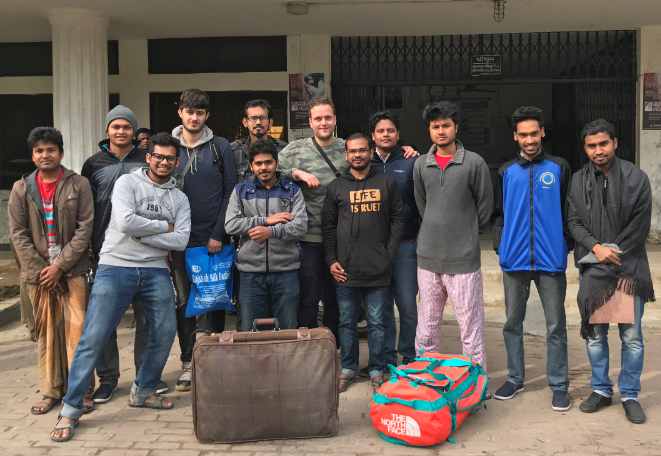Iron based Arsenic removal with biotic oxidation in Bangladesh
For our Bachelor thesis we, Arso Karlicic and Martijn Helsdingen, decided to perform a research project about arsenic removal from drinking water. With the help of Professor Doris van Halem, PhD-student Jink Gude and PhD candidate Md. Annaduzzaman a project in the rural areas of Bangladesh was realized. The project was executed in cooperation with RUET (Rajshahi University of Engineering & Technology), where we had a two month stay at the campus. This resulted in an unforgettable experience, where we had the opportunity to meet a lot of friendly people and embrace the Bengali culture.
Currently there are approximately 80 million people in Bangladesh, who are exposed to arsenic contaminated groundwater pumps, which exceed the threshold value set by the World Health Organization(WHO) of 10 μg/l. Also in the Rajshahi District the effects of this arsenic epidemic were clearly visible and we saw pumps regularly exceeding Arsenic concentrations of up to 80 μg/l.
To help tackle this large scale problem, we investigated if there is an economical feasible method to decrease the arsenic concentrations to meet the standards set by the WHO. In our search for such a method, two different households were selected where we installed our water treatment filter installations. The design of both of these filter installations was based on two treatment processes; the biotic oxidation of arsenic(III) into arsenic(V) and subsequent adsorption onto HFO flocs, which are retained in the filter media. The oxidation of arsenic(III) into arsenic(V) has shown to be crucial for effective removal of arsenic. The bacteria that governed this oxidation and the Iron(II), which through a few steps resulted in the formation of HFO, were naturally present in the groundwater in high concentrations. This means that no additional resources were needed during the treatment of the groundwater. Furthermore storage tanks were installed on the rooftops of both households, enabling a gravity based water supply. This way an economical feasible house filter installation was achieved. The same principles were applied at both locations, but different filter media were used to find an optimal treatment set-up.
To ensure that the installations worked properly and to keep track of how the earlier mentioned processes progressed, Arsenator tests were performed on site to give us an estimate of the arsenic concentrations at the different treatment steps. Additionally during this project approximately 750 samples were taken for further, more precise, analysis. These samples were tested with an ICP-MS at the TU Delft.
At the end we have found that the effluent of both water treatment installations had met the threshold value of 10 μg/l several times. The methods have shown to have great potential and high arsenic removal rates have been achieved of up to 93%. However the installations have shown to be unstable under unregulated circumstances, resulting in several setbacks in the removal of arsenic.

Arso Karlicic & Martijn Helsdingen
